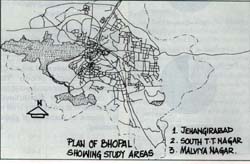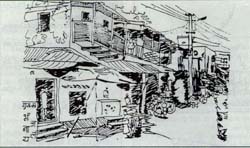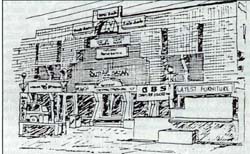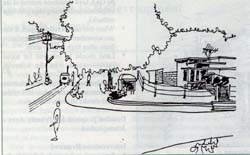|
An Approach to Redevelopment
Case Study - Bhopal
Ms. Shivani Singh
A
city is a living
organism and has its own genius. Planning for human settlements is
a continuous proces because the settlements are organic in nature,
never static, always sensitive to socio-economic and political
change which is reflected in their spatial and physical fabric.
There can be two approaches to accommodate future growth of the
city:
|
q |
New development by increasing existing urban sprawl. |
|
q |
By
redeveloping the old and bosolete urban areas so as to utilise
the land resource to its maximum potential. |
Redevelopment is a planning tool which can play a crucial role when
land pockets within the city lack coherence with the city fabric.
Such areas generally exhibit high land value which further justifies
redevelopment. The basic difference between renewal, revitalisation
and redevelopment is that the former two try to restore the old
character and rebuild what has been lost in time while redevelopment
is futuristic, it plans to accommodate the present and makes
provision for the future needs, and to provide an environment that
meets the social, psychological and the physical needs of the
people.
In
order to make redevelopment successful it is very important to take
the
 community into confidence and to discuss with them their
perceptions on redevelopment of the area. As redevelopment projects
without people’s participation invariably turn into case studies of
failure, it, is important to first organise the community so that
interaction on a day-to-day basis becomes easy. This can be
effectively done by forming Neighbourhood Committees in the project
areas. The community can participate actively and more directly in
the policy decisions. These neighbourhood committees can also be
made responsible for the maintenance of services. They will also
ensure that there is justice to all in the new plan and resources
are utilised optimally. These committees can also mobilise some
funds which can be helpful in the provision and maintenance of
social infrastrucutre; to build a sense of ownership among the
residents in the project areas. community into confidence and to discuss with them their
perceptions on redevelopment of the area. As redevelopment projects
without people’s participation invariably turn into case studies of
failure, it, is important to first organise the community so that
interaction on a day-to-day basis becomes easy. This can be
effectively done by forming Neighbourhood Committees in the project
areas. The community can participate actively and more directly in
the policy decisions. These neighbourhood committees can also be
made responsible for the maintenance of services. They will also
ensure that there is justice to all in the new plan and resources
are utilised optimally. These committees can also mobilise some
funds which can be helpful in the provision and maintenance of
social infrastrucutre; to build a sense of ownership among the
residents in the project areas.
Bhopal Case Study
Cities
are physical manifestation of the people and their activities.
Organic nature
 of
any traditional city is the outcome of that city being the will of
its people, specially the ones which have a historic character.
Bhopal is one such example. of
any traditional city is the outcome of that city being the will of
its people, specially the ones which have a historic character.
Bhopal is one such example.
Being
the capital of Madhya Pradesh, Bhopal is growing at a relatively
rapid pace with an increase in urbanisation around it. The
population is also growing due to inmigration not only from within
the state but also from seven neighbouring states which calls for
more pragmatic policies to absorb the population flows while
maintaining the aura of Bhopal’s own identity as a city of immense
natural beauty.
Discussed below are the steps involved in the process of
redevelopment:
Delineation of Study Areas
There
were two criteria to select the areas:
|
q |
Dominantly residential |
|
q |
Areas which were developed before an official plan was made for
the city i.e. before 1962
|
|
Based on these factors, three areas which fell under these
categories were: |
i. Jehangirabad:
Representing living areas which have deteriorated
with time due to over stressing of infrastructure, overcrowding,
ongoing development, no building controls, dilapidated structures
and obsolete landuses. It has a degraded social and physical
environment as a whole.
ii. South T.T.Nagar:
Low density areas located on prime land in the heart
of the city, housing the public sector employees and having mostly
unorganised open spaces, which are incidental and can be termed as
negative areas as they encourage encroachment and are prone to
becoming garbage dumps.
iii. Malviya Nagar:
Located in close proximity to the CBD and the Sub-CBD,
because of which these types of areas show rapid change in landuse.
The dominant market oriented landuse takes over but due to lack of
services to cater to the transformations, these areas become utter
chaos.
Selection of Priority Area
After
the three areas were selected a stress index was calculated for all
three and a “Quality Of Life” analysis was done by taking the
following factors:
Physical Parameters -
Water supply, sanitation, road width, type of structures,
maintenance level, percentage of slums, drainage, occupancy rate and
incompatiable landuses.
Social Parameters -
Crime
rate, social security, health and education.
Economic Parameters -
EWS
households and tenure status.
The
results of this comparative analysis revealed that Jehangirabad and
South T.T.Nagar were ripe for redevelopment while Malviya Nagar
required only policy interventions to arrest the existing chaos.
As
Jehangirabad is a privately owned area, while South T.T. Nagar is on
Government owned land, it was a more challenging job to work out
detailed plans for the redevelopment of Jehangirabad area. However
some interventions required for Malviya Nagar and South T.T. Nagar
are discussed below.
Possible Interventios for the Two Secondary Areas
Malviya Nagar
|
q |
Amenities to be provided as per standards for commercial and
Semi Public areas. |
|
q |
Instead of allowing a certain landuse for such areas it is
better to specify the incompatible landuse, thus making it a
more open and flexible approach. |
|
q |
The market forces should not be ignored as landuse is a self
regulatory process, the dominant or more efficient use takes
over. This is a process of development, so it should not be
overlooked and efforts should be made to accommodate the uses
which emerge with time. |
|
q |
Road Widths should be increased, by acquiring the setbacks of
the plots of the defaulters, who have changed the landuse, and
paying them necessary compensation. |
|
q |
Centralised parking lots to be provided in vacant land pockets,
and making the area mainly pedestrian |
|
q |
Incompatible landuse should be shifted out and space thus
created should be utilised in a more efficient manner. |
South T.T. Nagar
|
q |
The Master Plan of Bhopal recommends that this area should be
redensified in order to utilise the available land resource
better, so that more Government employees can be accommodated in
this area. The recommendation may be implemented. |
|
q |
As
the economic life span of existing structures is over, they can
be replaced by G+3, G+4 structures instead of the single
storeyed existing ones with huge setbacks. |
|
q |
When this area is redeveloped, it can accommodate inflows of
population from other high density areas. |
|
q |
Land should be reserved for social infrastructure like the
schools, hospitals, post-offices, etc. |
|
q |
The road pattern should be made more efficient and not more than
15% of the land should be under circulation. |
 |
 |
|
Changing
residential area to commercial area |
T. T. Nagar
- a low density area |
Detailed proposal for Priority Area-Jehangirabad
Interventions Required
|
q |
Structures to be made habitable, by carrying out repairs,
demolitions and reconstruction. |
|
q |
Decongest the area and create lung spaces. |
|
q |
Rectify the street pattern and improve the circulation. |
|
q |
Provide physical infrastructure to conform to the minimum
standards prescribed. |
|
q |
Provide social infrastructure such as schools, hospitals,
community cetnre. |
|
q |
Mixed landuse to be retained and only incompatible landuse to be
specified. |
|
q |
Organise the informal sector and allocate land pockets to them. |
|
q |
Relocate incompatible and inefficient landuse |
|
q |
Proposed plan to have increased Floor Area Ratio and also have
provisions made for in services provided. |
|
q |
New construction to conform to building bye-laws and development
controls. |
Potential of Jehangirabad
This
area is the transition area between the old and the new Bhopal, and
is located within the radius of 2kms. of the CBD and the sub-CBD.
The land value of this area is very high. The absence of a
commercial centre in this particular district supports mixed landuse
for this area. The percentage of rented houses is low.
In
order to bring about the required interventions the area was divided
into two categories based on 3 criteria.
|
q |
Width of the road facing the properties should be at least 12
mts. |
|
q |
Income category - 60% households in the MIG or HIG category. |
|
q |
Overall street pattern of the proposed layout, which was to
retain the peripheral properties and to reconstruct them on the
present location. |
Category I was the area conforming to these conditions. The rest of
the area fell under Category II.
Process For Category I
“Owners to redevelop their own properties”. If the owners fail to
do so within the stipulated time frame they are liable to be
penalised by the neighbourhood committees. To facilitate the
process, Government can offer incentives like:
|
q |
Free technical guidance |
|
q |
Provision of loans at lower interest rates and through a one
window process to be arranged by local bodies in coordination
with institutions like HUDCO. |
|
q |
Provision of services at no profit, no loss basis |
|
q |
20% increased FAR |
|
q |
25% built area for non residential but compatible
landuse. |
Process for Category II
|
q |
Government will act as a facilitator and appoint an NGO to
co-ordinate the process of redevelopment. The NGO will help
form neighbourhood committees, who will in turn help to create
awareness amongst the residents and help them realise the
benefits of the programme. Government will also provide
temporary locations for rehabilitation of the people during
reconstruction. |
|
q |
The large plot owners will contribute
to the pool of land to provide infrastructure. Compensation for
the land acquired should be paid to the plot owners, by the
government agency. |
|
q |
Part of the pool land to be reserved
as remunerative land, which is sold at market price, to met the
cost of services provided and for the maintenance of the same.
thus the community can become self-reliant, and not be at the
mercy of the authorities for achieving better physical and
social environment. |
|
q |
Private builders can be involved in
this process after co-operatives are formed and the residents
have consolidated the land, as per the approved plan of the
area. Private builders can be given incentives like increased
FAR as land values are very high. |
In Bhopal,
the competent authority to carry out redevelopment is Slum
Improvement Board in coordination with Bhopal Development Authority.
q
Back to Contents
|